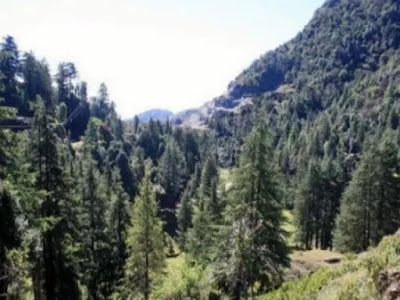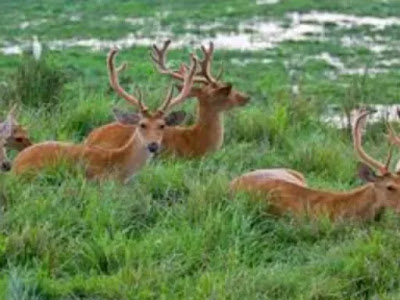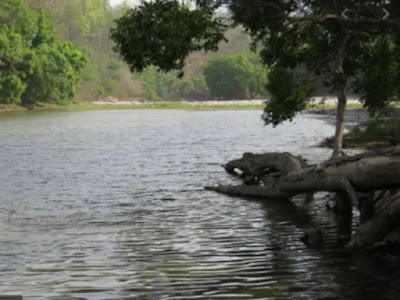About Uttarakhand and Its Tourist Places
The State of Uttarakhand was formed on 9 November 2000, as the 27th state of India. There are 13 Districts in Uttarakand.
Presently, Uttarakhand divided
into two divisions (Mandal).
- First Kumaon Division (Mandal) six districts comes in the Kumaon Division (Mandal).
- Second Garhwal Division (Mandal) seven districts comes in the Garhwal Division (Mandal).
Uttarakhand is also known as Dev Bhoomi(Land of God) Uttarakhand is a prosperous state in terms of natural and religious tourism places, according to the State Statistics Diary 2011 to 2012, there are a total of 264 tourist places.
Uttarakhand is famous for its
religious places like Char Dham, Panch
Kedar, Panch Badri, Panch Prayag , Tapta Kund, etc. Similarly, Tourists
from all over the country and the world visit the holy shrine places of
Uttarakhand. Tourism economy point of view Uttarakhand is the 7th
Largest Tourism economy in the world and ninth largest in cultural resources
and business travel in the world.
Popular New Emerged Tourist Destinations in Uttarakhand
Popular new
emerged Tourist Destinations in Uttarakhand famous places for Pilgrimage
traveling natural and wildlife resources
which Tourist like the most to visit. Pilgrimage is a major area of traditional
tourism in Uttarakhand. However, with enormous resources for cultural,
adventure, wildlife, etc., many new places have also been emerged as popular
tourist places like as Aero Sports in Naukuchiyatal, Mountain Biking in
Rudraprayag to Gopeshwar Route, Rafting in Rishikesh, Skiing in Auli, Trekking
in Munsyari, Roop Kund etc.places to visit in uttarakhand in december is best time to visit uttarakhand,
Popular Nature and Wildlife - Tourist Destinations in Uttarakhand
National Park
Corbett National Park
Corbett NationalPark, which was previously known as Haley national park that was named after
the state's governor, Sir Haley, is the first national park not only in India
but also in Asia. After Independence it was named Ramganga National Park. Once
again in 1957, it was renamed to Jim Corbett National Park, which was kept in
memory of natural lover Jim Corbett.
Jim Corbett National Park is spread over 520.82 sq km. The park is spread over 312.76 km in Pauri and 208.8 km in Nainital.
Jim Corbett National Park is spread over 520.82 sq km. The park is spread over 312.76 km in Pauri and 208.8 km in Nainital.
To enter this
park, an entrance has been made at Dhikala in Nainital, which is 144 km away
from the district headquarters of Nainital, Patali Doon is situated in the
center of this park. It was declared India's first tiger reserve on 1 November
1973.
About 570 bird
species, 25 reptile species, mammals are found in this park Crocodile, Chital,
Sambar, Kakad, tiger, elephant, leopard, deer etc. are the main creatures
found in this National Park. Among all of the National parks of the state, most
tourists come to the Jim Corbett National Park, after this, Rajaji National
Park and Valley of Flowers respectively.
Nanda Devi National Park
Nanda Devi
National Park is spread over an area of 624 square kilometers on the border in
Chamoli district of the state.
This national park was established in 1982, this park is situated at an altitude of 5431. Himalayan Bear, Snow Leopard, Monal, Musk Deer etc.,
Tourists come from far and wide to see them. Its headquartered is in Joshimath.
This national park was established in 1982, this park is situated at an altitude of 5431. Himalayan Bear, Snow Leopard, Monal, Musk Deer etc.,
Tourists come from far and wide to see them. Its headquartered is in Joshimath.
Rajaji National Park
Rajaji National Park was established in 1983, it is spread over an area of 820.42 square kilometers. Rajaji National Park extends to the districts of Dehradun, Haridwar and Pauri Garhwal.
Tourists come here in large numbers. The park has 23 types of mammals like elephant, lion, cheetah, tiger, nilgai etc. there are 313 types of birds are found in the Rajaji National Park.
Its headquarters is in Dehradun.
Fauna
Benog Wildlife Sancturay
A part of the Rajaji National Park, Benog Wildlife Sanctuary is located at the Queen of Hills Mussoorie.
It is surrounded by Benedict pines, old cedar trees and medicinal plants growing in abundance in the region. Tourists come here in large numbers. The sanctuary has evolved into a bird watching and is home to a wide variety of birds such as the White Capped Water Redstart and Red Build Blue Magpai, to name a few.
The view of the snow-capped Chaukhamba and Bandarpanch peaks can also be enjoyed from here.
Kedarnath Wildlife Sancturay
Kedarnath Wildlife Sanctuary, also known as Kedarnath Kasturi Deer Sanctuary, declared under the Wildlife Conservation Act, 1972 and is a wildlife sanctuary located in Uttarakhand, India.
Its alternate name comes from its primary objective of protecting the endangered Himalayan musk deer. Consisting of an area of 975 km2, it is the largest protected area in the Western Himalayas. It is famous for Alpine Musk Deer, Himalayan Thar, Himalayan Griffon, Himalayan Black Bear, Snow Leopard and other flora and fauna.
Tourists come from far and wide to see them. It is internationally important for the diversity of its flora and fauna.
Askot Wildlife Sancturay
This Wildlife
Sancturay was established in 1986, it is spread over an area of 600 sq km, it
is located in Pithoragarh.
This sanctuary is established primarily for the purpose of preserving the musk deer and its habitat. The major wildlife animals found here are snow tiger, bear, snow bear, bear musk deer etc.
Many Species of high altitude birds are also found in this sanctuary.
This sanctuary is established primarily for the purpose of preserving the musk deer and its habitat. The major wildlife animals found here are snow tiger, bear, snow bear, bear musk deer etc.
Many Species of high altitude birds are also found in this sanctuary.
Sonanadi Wildlife Sancturay
Sona River
Wildlife Sancturay established in 1987, this wildlife sanctuary is spread over
an area of 301 square kilometers, it is located in Pauri Garhwal.
It is a 3-hour safari by jeep, in which you can experience the forest of Sonanadi.
This Wildlife sanctuary is fomous for Elephant, Lion, Guldar, Chital, Sambar, Kakad, Jackal, Wild Bear, Python etc.
It is a 3-hour safari by jeep, in which you can experience the forest of Sonanadi.
This Wildlife sanctuary is fomous for Elephant, Lion, Guldar, Chital, Sambar, Kakad, Jackal, Wild Bear, Python etc.
Flora
Nanda Devi Biosphere
Nanda Devi
National Park is spread over an area of 624 square kilometers on the border in Chamoli
district of the state.
This national park was established in 1982, this park is
situated at an altitude of 5431.
Himalayan Bear, Snow Leopard, Monal, Musk Deer
etc., and its headquartered is in Joshimath.
Corbett National Park
Corbett National Park, which was previously known as Haley national park that was named after the state's governor, Sir Haley, is the first national park not only in India but also in Asia. After Independence it was named Ramganga National Park. Once again in 1957, it was renamed to Jim Corbett National Park, which was kept in memory of natural lover Jim Corbett.
To enter this
park, an entrance has been made at Dhikala in Nainital, which is 144 km away
from the district headquarters of Nainital, Patali Doon is situated in the
center of this park. It was declared India's first tiger reserve on 1
November 1973.
About 570 bird species, 25 reptile species, mammals are found in this park Crocodile, Chital, Sambar, Kakad, tiger, elephant,t leopard, deer etc. are the main creatures found in this National Park. Among all of the National parks of the state, most tourists come to the Jim Corbett National Park, after this, Rajaji National Park and Valley of Flowers respectively.
About 570 bird species, 25 reptile species, mammals are found in this park Crocodile, Chital, Sambar, Kakad, tiger, elephant,t leopard, deer etc. are the main creatures found in this National Park. Among all of the National parks of the state, most tourists come to the Jim Corbett National Park, after this, Rajaji National Park and Valley of Flowers respectively.
Govind National Park
Rajaji National
Park was established in 1983, it is spread over an area of 820.42 square
kilometers. Rajaji National Park extends to the districts of Dehradun, Haridwar
and Pauri Garhwal.
The park has 23 types of mammals like elephant, lion, cheetah, tiger, nilgai etc.
There are 313 types of birds are found in the Rajaji National Park. Its headquarters is in Dehradun.
The park has 23 types of mammals like elephant, lion, cheetah, tiger, nilgai etc.
There are 313 types of birds are found in the Rajaji National Park. Its headquarters is in Dehradun.
Valley of Flowers
Valley of
Flowers National Park is located in Chamoli district in Uttarakhand, about 150
km from the headquarters of Chamoli district, at an altitude of 3600 meters
above sea level, between the Male and Gandhamadan ranges. The Valley of Flowers
was declared a National Park in 1982.
The main attraction here is thousands of flowers and rare animals, of which this valley is spread over an area of 87.5 kilometers. There are many different types of flowers found here. The headquarters of this Valley is in Joshimath.
The main attraction here is thousands of flowers and rare animals, of which this valley is spread over an area of 87.5 kilometers. There are many different types of flowers found here. The headquarters of this Valley is in Joshimath.
Numerous
medicinal property flowers are also found here such as Koot, Som, Ratanjot,
etc. The credit for locating the valley of flowers goes to the mountaineer
Frank Smith. The valley is called Nandankanan in Kedarkhand of Skanda Purana,
Mahakavi Kalidas has called it Alka in Meghdoot. This valley is also known as
Gandhamadan, Baikuntha, Bhandar, Frank Smith etc.
Flowers of different species found in the beautiful valley and the smell of these flowers attracts the tourist towards him.
Flowers of different species found in the beautiful valley and the smell of these flowers attracts the tourist towards him.
Hill Stations in Uttarakhand for Tourist
Nainitall Tour Information
Nainital is
known as the city of lakes. Nainital City is surrounded by three sides of Tiffin
Top, China Peak, Ladia Thorn, Snowview Hadiya, Lion's Blackjack and High Hills.
The town is situated at an altitude of about 1938 meters above sea level on the
world tourism map, it is a tourist destination where are the most lakes found. There
is Naini lake / Tal in the middle of this city whose length is about 1500
meters, width 510 meters and depth is 10 to 156 meters. This lake is surrounded
by seven hills on three sides(Eyre Paat, Devpath, Hadigarhi, China Peak,
Snowview, Alamsaria Kanta and Sher Ka Daanda coldest place in uttarakhand in june.
. The upper part of the palate is called Mallital and the lower part is called Tallital. After becoming railway line in Kotgodam in 1882 and the district headquarters in 1891, this city lake developed rapidly.
. The upper part of the palate is called Mallital and the lower part is called Tallital. After becoming railway line in Kotgodam in 1882 and the district headquarters in 1891, this city lake developed rapidly.
Raj Bhavan was established at Mallital in
Nainital in 1900 which was used as the summer capital of Uttar Pradesh since
1962. After the state formation in 9 November 2000 the Uttarakhand High Court
has been shifted to this building.
The Major
tourist spots of Nainital district are Naina Devi Temple, Snow View, Naini Lake,
Nal Ta,l Bhawali, Bhimtal, Kainchi Dham, Landends, Corbett National Park, Kaladhungi, Vedshala, Ghorakhal,
Kathgodam, Haldwani, Ramgarh, Ramnagar, and Garjia.
Mussoorie
Queen of the
mountains Mussoorie Mussoorie is one of the oldest hill stations in India. The
original founder of the Mussoorie city was an Irish officer working in the
Bengal Army of the East India Company. On 4 March 1820, Tehri Naresh Sudarshan
Shah leased the present land of Mussoorie city for 80 years to the East India
Company through a treaty. The town is located 32 kilometers from Dehradun its offers
a stunning view of the Himalayan mountain ranges in the North East.
Mussoorie is the gateway to the temples of Gangotri and Yamunotri, the highest peak is the Gunhill hill. Among the scenic spots here are Kapti Fall, Camel's Back, Municipal Garden, Messi Falls, Sahastradhara, Chakrata Falls, Surcharged Forest House, Nag Tibba, Dhanaulti, Landor Bazar and Kulri Bazar etc., are the famous Tourist places of Mussooie and chaukori hill stations uttarakhand
Mussoorie is the gateway to the temples of Gangotri and Yamunotri, the highest peak is the Gunhill hill. Among the scenic spots here are Kapti Fall, Camel's Back, Municipal Garden, Messi Falls, Sahastradhara, Chakrata Falls, Surcharged Forest House, Nag Tibba, Dhanaulti, Landor Bazar and Kulri Bazar etc., are the famous Tourist places of Mussooie and chaukori hill stations uttarakhand
Lansdowne
This military
town is located at a distance of 37 km from Kotdwar and 81 km from Pauri. This
place was discovered by Lord Lansdowne in 1887, so the place was named after
him. The command office of the famous Garhwal Rifle of the Indian Army is also
situated here. There is a temple of the famous Kaleshwar Mahadev here due to
which, this city is also called Kaleshwar.
The war memorial and the Garhwali mess are worth scenic spot. The Tarakeswar Shiva temple is located at a distance of 36 km from Lansdowne, from where the rivers Vish Ganga and Madhu Ganga originate.
The war memorial and the Garhwali mess are worth scenic spot. The Tarakeswar Shiva temple is located at a distance of 36 km from Lansdowne, from where the rivers Vish Ganga and Madhu Ganga originate.
Devalgarh has
been the capital of the Garhwal kings, which was later established in Srinagar.
Here is an ancient temple of Rajarajeshwari Devi, famous as the Kuldevi of the
Garhwal King, it is situated at an altitude of 4000 feet, about 20 km from
Srinagar.















